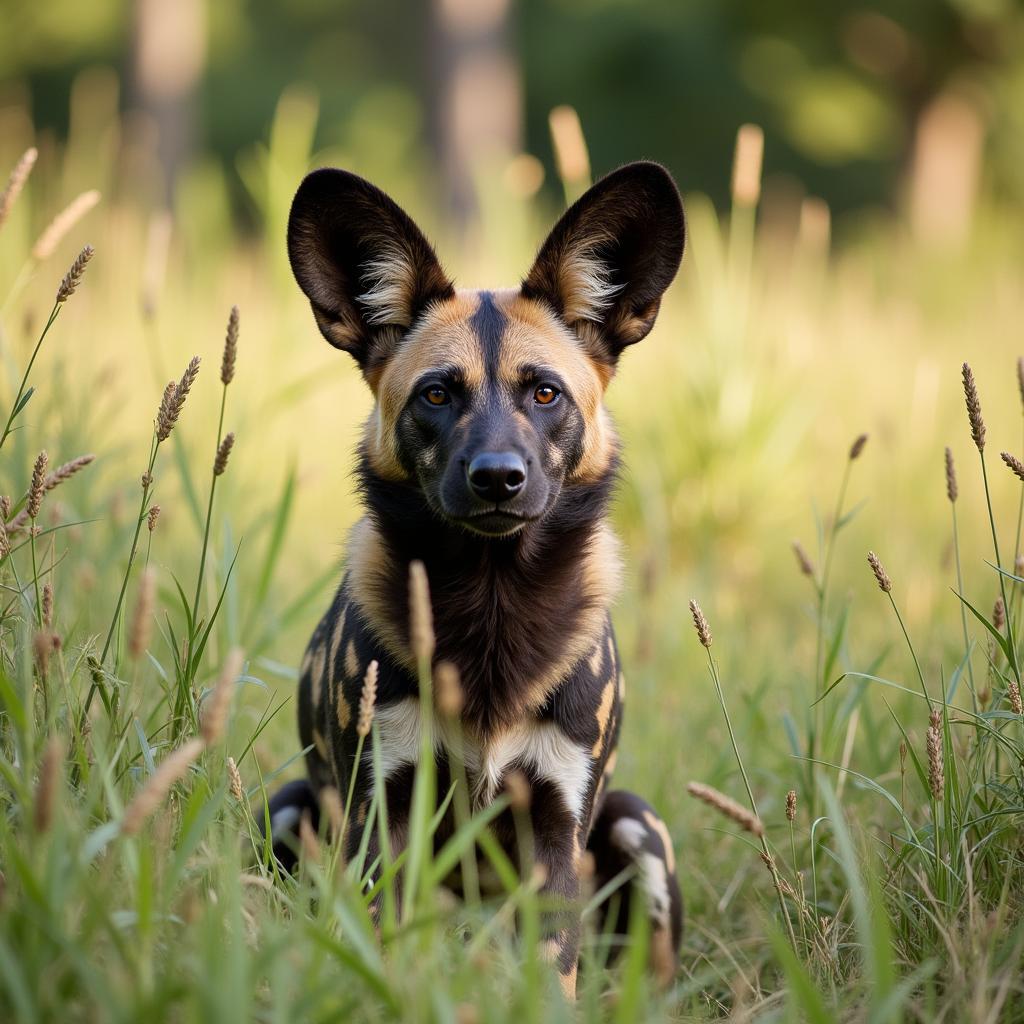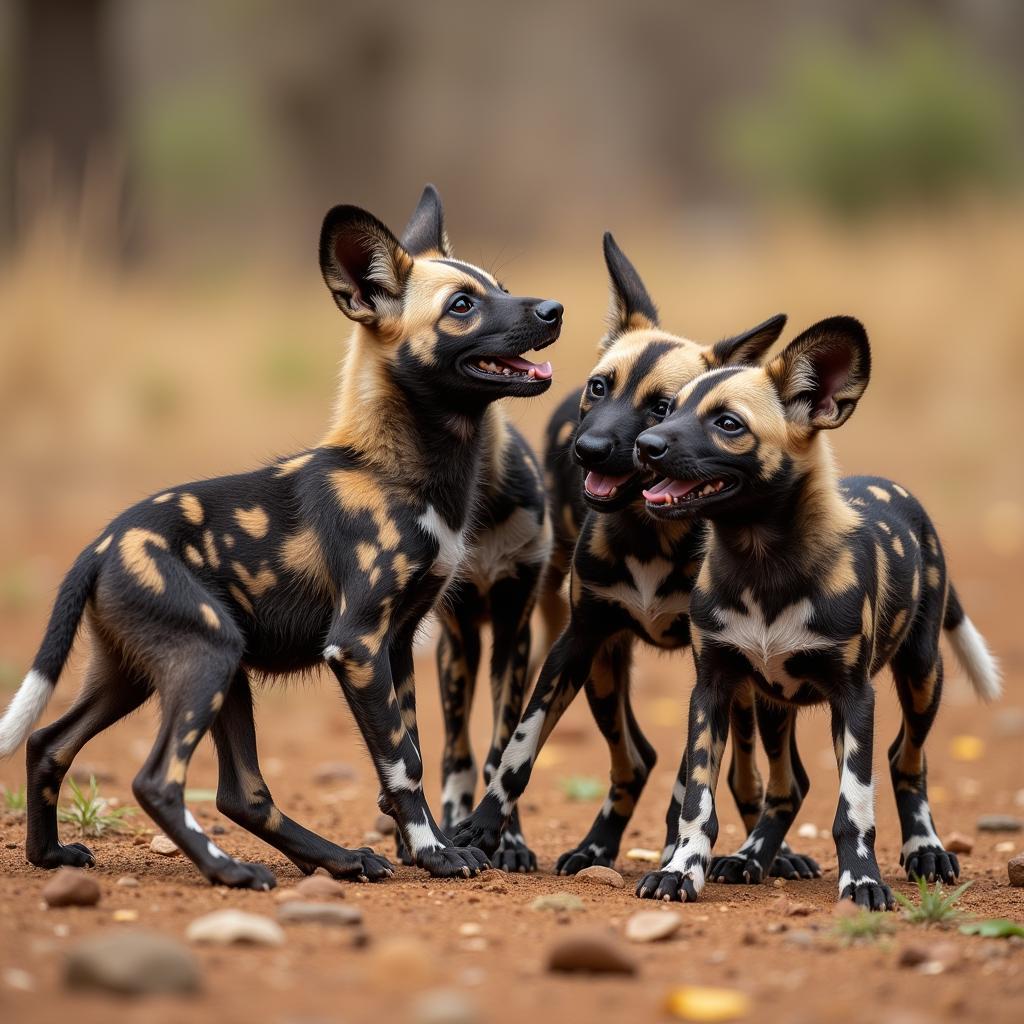The African Wild Dog: A Closer Look at the Striped Predator
The African wild dog, easily identifiable by its unique and striking coat pattern, is a fascinating creature that embodies the untamed spirit of Africa. Often referred to as the “painted wolf” or “African painted dog”, this captivating canine is a testament to the continent’s rich biodiversity. While its striped appearance is its most recognizable feature, there’s much more to this social carnivore than meets the eye.
Unveiling the Stripes: Why Does the African Wild Dog Have Them?
Unlike any other canine in Africa, the African wild dog boasts a beautiful and irregular coat of black, yellow, brown, and white patches. But what’s the reason for these distinctive stripes? Scientists believe this bold pattern serves a crucial purpose: camouflage.
Imagine the dappled light filtering through the African savanna’s tall grasses and scattered acacia trees. The wild dog’s coat breaks up its outline, making it difficult for prey animals to spot them amidst the shadows and sunlight. This natural camouflage is essential for their survival as skilled hunters in the challenging African landscape.
 African wild dog camouflaged in grassland
African wild dog camouflaged in grassland
More Than Just a Pretty Pattern: Stripes for Social Recognition
While camouflage is a primary function, the unique markings of each African wild dog also play a crucial role in social recognition. Just like our fingerprints, no two wild dogs share the same coat pattern. This individuality allows members of a pack to identify each other quickly, which is essential for coordinated hunting and maintaining pack hierarchy.
A Pack Animal: Social Structure and Hunting Strategies
The African wild dog is a highly social animal, living in packs that can range from a few individuals to over 20. Their cooperative nature extends to their hunting strategies, making them one of the most successful predators in Africa.
A Symphony of Communication: How Wild Dogs Coordinate
Before a hunt, the pack engages in elaborate greeting ceremonies, reinforcing social bonds and possibly deciding on hunting strategies. These ceremonies often involve a chorus of high-pitched twittering calls, whines, and short barks, showcasing their complex communication system.
Masters of Endurance: The Chase is On!
Once the prey is targeted, the chase begins. African wild dogs are known for their incredible stamina and can maintain speeds of up to 60 km/h over long distances, wearing down their prey until exhaustion.
Facing the Threats: Conservation Challenges and Hope for the Future
Sadly, these remarkable creatures are listed as “Endangered” by the International Union for Conservation of Nature (IUCN). Habitat loss, disease outbreaks, and human conflict have significantly impacted their populations.
 African wild dog pups playing
African wild dog pups playing
However, there is hope. Dedicated conservation efforts are underway across Africa to protect these magnificent animals and their habitat. From anti-poaching patrols to community education programs, these initiatives strive to ensure the survival of the painted wolves for generations to come.
The African Wild Dog: A Symbol of African Wildlife’s Resilience
The African wild dog, with its striking stripes and fascinating social dynamics, embodies the captivating beauty and ecological importance of Africa’s wildlife. By understanding and appreciating these unique creatures, we can contribute to their conservation and ensure that the African savanna continues to echo with the sounds of the painted wolves.
FAQs about African Wild Dogs
1. What is the lifespan of an African wild dog?
In the wild, African wild dogs typically live for 10-12 years.
2. What do African wild dogs eat?
They primarily prey on medium-sized antelopes like gazelles and impalas.
3. Where can I see African wild dogs in the wild?
Some of the best places to see them include national parks and reserves in Botswana, Tanzania, and South Africa.
4. Are African wild dogs dangerous to humans?
Attacks on humans are extremely rare. However, it’s important to observe them from a safe distance and respect their space.
5. How can I help protect African wild dogs?
You can support conservation organizations working to protect them, spread awareness about their plight, and advocate for responsible tourism practices.
For further exploration of African wildlife, check out these resources:
- Explore the diversity of African animals names with pictures.
- Discover the captivating world of African animals pictures with names.
Need more information about African wildlife? Contact us:
Phone: +255768904061
Email: kaka.mag@gmail.com
Address: Mbarali DC Mawindi, Kangaga, Tanzania
We’re available 24/7 to answer your questions and provide assistance.